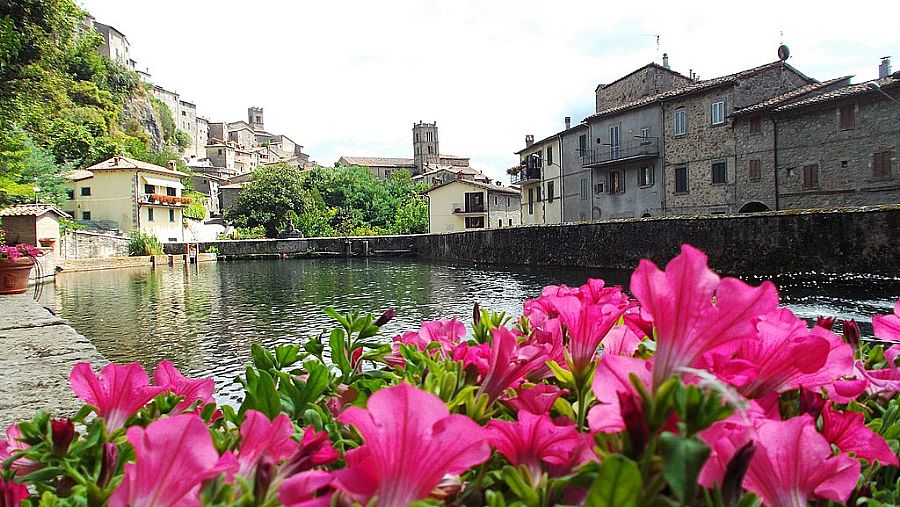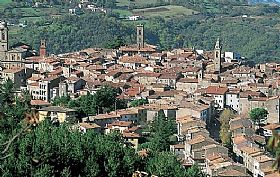Roccalbegna

This pretty village is anchored on a cliff between its castle and a stone fortress rooted on a rock. Roccalbegna seems carved out of the cliffside and looms over the river valley. A spur of rock overlooking the Albegna River gives the town its name: Rocca (rock) Albegna (the river valley). It is on the slopes of Monte Amiata in southern Tuscany, tucked in a natural realm of woods and rivers, so different from the rolling hills typical in central Tuscany. A tall rock called the Sasso rises sharply behind, and there are two large nature reserves that contain undisturbed landscapes, animals, birds and forests.
The town is in a dramatic setting at the foot of two steep and picturesque cliffs, tethered by the Cassero Senese fortress on one side and the Castello La Pietra on the other. Both date to the 13th century when the powerful Aldobrandeschi family controlled these territories. In between stretch a length of city walls that once protected it (just in case the natural barriers and fortresses weren't enough). Towers scattered through the center of town kept additional vigil.
The town has medieval origins and was part of the Aldobrandeschi family's possession; it came under the domain of the Republic of Siena, under whose jurisdiction it remained until the mid-16th century. With the fall of the Republic, the Medici's took possession of Roccalbegna and gave it to the town of Santa Fiora. In the late 18th century it became a free city of the Grand Duchy of Tuscany.
The best time to visit Roccalbegna is at the end of November for the the ancient ritual of fire, called the "Focarazza". It is held on the evening of November 24, eve of St. Catherine's feast day. The evening begins with a procession led by the parish priest to the top of town. There is a carefully arranged bonfire of precisely laid logs surrounding a tall mast-like pole in the center (called a stollo). After a mass of dedication and a blessing of the bonfire, the logs are set ablaze in homage to St. Catherine (who was burned at the stake). The flames leaping up in the air can be seen from all over the surrounding countryside and people gather around it as a symbol of purification. When the intensity of the fire wanes, the town's traditional Palio begins. In a feat of daring (and downright danger) teams of men risk the flames and smoke to reach the stollo. They then run through the streets back to the piazza of their district, where it is cut up and distributed to other families in the quartiere. After it burns down, the ashes are scattered in their fields as a blessing.
But there are artistic treasures to enjoy in Roccalbegna, too. The Church of San Pietro e Paolo is a must see; the spare Romanesque facade and Gothic portal don't prepare you for the brilliant artwork inside, including a beautiful triptych by Lorenzetti, frescoes and more. A museum at the Oratorio contains religious art from three churches.
Wander around the cobbled lanes of the pastel-painted town and enjoy the Old World charm with intriguing alleys and archways. In particular, look for the romantic Via dell'Amore, where local legend holds that lovers who kiss beneath the archway will have eternal amore. There are many other little gems to find amongst the streets of Roccalbegna, but we won't tell you about them! We're not holding out on you, we just think that you deserve the joy of discovery that even a short visit to Roccalbegna will give you!
Explore handpicked holiday lettings in Tuscany.

 Amalfi Coast
Amalfi Coast Sorrento Coast
Sorrento Coast Tuscany
Tuscany Cilento National Park
Cilento National Park Lake Como
Lake Como Rome and Latium
Rome and Latium Umbria
Umbria Capri and Ischia
Capri and Ischia Venice
Venice Puglia (Apulia)
Puglia (Apulia) Liguria
Liguria Sicily
Sicily Lake Maggiore
Lake Maggiore Lombardy
Lombardy Sardinia
Sardinia Lake Garda
Lake Garda Abruzzo and Marche
Abruzzo and Marche Calabria
Calabria


Been there? Done that? Share your experience and tips!
Haven't visited yet? Have questions about Roccalbegna? Ask them here!